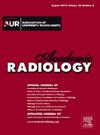What Program Directors Think About Resident Recruitment: Results of the 2023 Spring Survey of the Association of Program Directors in Radiology (APDR) Part I
IF 3.8
2区 医学
Q1 RADIOLOGY, NUCLEAR MEDICINE & MEDICAL IMAGING
引用次数: 0
Abstract
Rationale and Objectives
The Association of Program Directors in Radiology (APDR) administers an annual survey to assess issues and experiences related to residency program management and education. Our purpose is to provide the response data from the 2023 survey and discuss its insights on the impact of COVID-19 on resident recruitment (Part I) and education (Part II), which can be used to facilitate planning and resource allocation for the evolving needs of programs and their leadership. In Part I, we consider the effects of ERAS preference signaling, the virtual interview format, and the potential of a universal interview release date.
Materials and Methods
An observational, cross-sectional study of the APDR membership was performed using a web-based survey consisting of 45 questions, 23 of which pertain to virtual recruitment and are discussed in Part I of a two-part survey analysis. All active APDR members (n = 393) were invited to participate in the survey.
Results
The response rate was 32% (124 of 393). 83% reported that signaling increased the likelihood of an interview offer. 96% reported only offering virtual interviews; however, 59% intended to offer virtual-only interviews in the future. 53% would adhere to a universal interview release date but an additional 44% would do so depending on the agreed date, Results were tallied using Qualtrics software and qualitative responses were tabulated or summarized as comments.
Conclusions
Virtual recruitment is expected to continue for many programs and most respondents would accept a universal interview release date. Preference signaling and geographic signaling are considered positive additions to the application process.
项目主任对住院医师招聘的看法:放射学项目主任协会(APDR)2023 年春季调查结果(第一部分)。
理由和目标:放射学项目主任协会(APDR)每年都会进行一次调查,以评估与住院医师项目管理和教育相关的问题和经验。我们的目的是提供2023年调查的回复数据,并讨论COVID-19对住院医师招募(第一部分)和教育(第二部分)的影响,这些数据可用于促进规划和资源分配,以满足项目及其领导层不断变化的需求。在第一部分中,我们考虑了ERAS偏好信号的影响、虚拟面试形式以及通用面试发布日期的可能性:我们对APDR成员进行了一项观察性横断面研究,通过网络调查提出了45个问题,其中23个问题与虚拟招聘有关,将在调查分析的第一部分进行讨论。所有活跃的 APDR 会员(n = 393)都受邀参加了调查:答复率为 32%(393 人中有 124 人)。83%的受访者表示,信号传递增加了获得面试机会的可能性。96%的人表示只提供虚拟面试;但59%的人打算今后只提供虚拟面试。53%的受访者会遵守统一的面试发布日期,但还有 44% 的受访者会根据约定的日期进行面试:结论:预计许多项目将继续采用虚拟招聘,大多数受访者将接受统一的面试发布日期。偏好信号和地理信号被认为是对申请过程的积极补充。
本文章由计算机程序翻译,如有差异,请以英文原文为准。
求助全文
约1分钟内获得全文
求助全文
来源期刊

Academic Radiology
医学-核医学
CiteScore
7.60
自引率
10.40%
发文量
432
审稿时长
18 days
期刊介绍:
Academic Radiology publishes original reports of clinical and laboratory investigations in diagnostic imaging, the diagnostic use of radioactive isotopes, computed tomography, positron emission tomography, magnetic resonance imaging, ultrasound, digital subtraction angiography, image-guided interventions and related techniques. It also includes brief technical reports describing original observations, techniques, and instrumental developments; state-of-the-art reports on clinical issues, new technology and other topics of current medical importance; meta-analyses; scientific studies and opinions on radiologic education; and letters to the Editor.
 求助内容:
求助内容: 应助结果提醒方式:
应助结果提醒方式:


